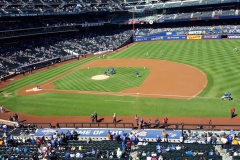On May 20th the Texas Rangers and City of Arlington announced a $1 billion partnership to replace the Rangers current home, Globe Life Park, with a retractable roof ballpark for the 2021 season. During the introductory press conference Arlington Mayor Jeff Williams announced the partnership would be a 50/50 split, with $500 million coming from the Texas Rangers. The announcement was a surprise, as Globe Life Park has been in use for 22 years and the team’s recent success bringing fans to the ballpark despite the heat during the summer months. The new Rangers Ballpark would be the centerpiece of a Texas Live! entertainment district that would include a concert venue, a hotel, bars and restaurants.
A closer look at the Ballpark’s Master Agreement details a portion of the Rangers $500 million share will come from fans through ticket and parking taxes. State law allows the taxes to be used to fund the city’s portion of construction costs, however the City of Arlington will transfer these funds to the Rangers. Mayor Jeff Williams feels the Rangers “deserve extra tax support”. In March 2016 Forbes valued the Texas Rangers franchise at $1.225 billion, a 118% increase in value from their 2011 valuation. You’re not going to find a bigger fan of ballparks that I, but if the Texas Rangers wants a new ballpark they can fund it themselves. The transfer of ticket and parking taxes from the City of Arlington to the Rangers billionaire owners will result in an estimated 80/20 split with the tax payer funding $800 million of the project.
Brett Shipp and Mark Smith of WFAA in Arlington reviewed the proposed ballpark’s funding with two stadium economists and discovered a deal that did not sound promising for the residents of Arlington. “It is one of the worst public projects anyone could imagine,” said Robert Baade, an economist at Lake Forest College in Illinois. The proposed “50/50” split is similar to the Marlins Park agreement that resulted in the public funding over 80%, receiving little in return. Current Miami-Dade Mayor Carlos Gimenez said voters should study details behind any public-private partnership. He serves today in part because of his opposition of the Marlins Park deal. He feared taxpayers would be held responsible for paying down debt while Marlins ownership, led by Jeffrey Loria, would receive the economic benefit. This prediction has held true as the Marlins’ Forbes valuation increase from $360 million in 2011 to $675 million in 2016. Marlins Park opened in 2012 and has not helped increase attendance, averaging below twenty-two thousand fans per game since it’s debut where it averaged twenty-seven thousand. This is a slight increase from the less than twenty-thousand fans that showed up at Sun Life Stadium, the Marlins previous home. Also, the area surrounding Marlins Park, Little Havana, has not been developed as mentioned in the park’s plans.
It’s up to residents of Arlington, like Jim Runzheimer, to vote down the additional funding. “This is a total giveaway by the taxpayer to a private business that does not need any taxpayer assistance,” said Runzheimer, who has lobbied against Arlington’s plans to raise taxes for sports stadium construction. Mayor Jeff Williams spins the additional funding provided by Arlington as an investment with the Rangers, assuring they will remain in North Texas. However when pressed to mention potential destinations for the franchise Mayor Williams said the following “I could name lots of cities, but I’m not going to disclose that. But I can tell you there are a lot of cities that would like to have the Texas Rangers.” Villanova professor Rick Eckstein, who studies sports stadium economics, calls it a sleight of hand. “There’s verbal gymnastics going on,” he added. “It’s relatively unprecedented in terms of stadiums I’ve studied over the last 20 years.” Voters will have their say in November.





